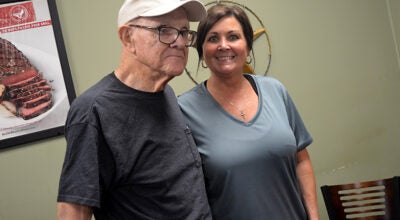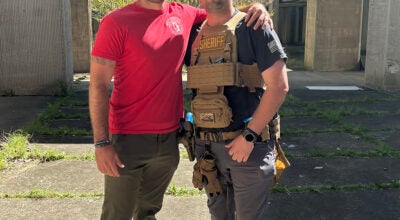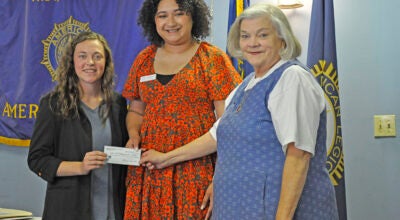Operator error likely cause of LifeFlight crash
Published 3:00 am Friday, June 15, 2018
After two years, the National Transportation Safety Board has released a final report on the probable cause of the crash that killed four people aboard a Haynes LifeFlight helicopter .
The report states that the pilot, 29-year-old Chad Hammond, most likely experienced spatial disorientation while flying in low visibility conditions on March 26, 2016. The report also said “get-there-itis” likely played a role in Hammond deciding to attempt the flight to Montgomery despite limited visibility conditions.
Hammond, two other crew members and the patient were killed in the crash that took place within minutes of taking off from the scene of a motor vehicle accident in Coffee County. The LifeFlight crew departed from the station at Troy Regional Medical Center to pick up the severely injured driver, Zach Strickland, 27, and transport him to Montgomery.
The final NTSB report released May 24 states that Hammond’s “fixation on completing the mission probably motivated him to depart on the accident flight in IMC (instrument meteorological conditions), even though significantly less risky alternatives existed, such as canceling the flight and transporting the patient by ground ambulance.”
Peter Knudson, NTSB spokesman, explained spatial disorientation and “get-there-itis” and how they factor into a crash.
“Get-there-itis,” Knudson said, is a colloquial term that means a pilot is driven by a very strong desire to complete a trip, which can be caused by external or internal pressures.
Knudson said spatial disorientation is a “big killer” that factors into many of the crashes that the NTSB investigates.
“Our vestibular system is not designed for flight,” Knudson said. “If you don’t know where you are in reference to outside references such as the ground or a mountain, you will gradually become spatially disoriented … you become unaware of your orientation.”
Knudson said the final report closes the investigation. He said no new safety measures have been recommended based on the investigation.
The full 21-page report also points to a failure in communication by the operation control center which Metro Aviation, the operator employing Hammond, used for operational control of its flights.
The report details how two operational control coordinators, a trainee and a senior operational control coordinator, received notification of the request for the chopper to respond to the scene of the wreck. The coordinators reportedly entered the coordinates of the wreck into a software program called “OCC Helper” to collect weather information for the site, and although the coordinates were input correctly, the format was incorrect and the software only showed the visual conditions at the helicopter’s base in Troy – not the instrument meteorological conditions at the site of the wreck.
“The trainee reported that latitude and longitude format was a common problem with OCC Helper and, at times, required OCC personnel to reformat the latitude and longitude coordinates to get the coordinates to work in OCC Helper,” the report states. “On the night of the accident, the incorrectly formatted latitude and longitude for the … site were not corrected in OCC Helper until after the helicopter had departed its base en route to the … site. Given the IMC weather conditions being reported, which were below the required VFR (visual flight rules) weather minimums for the flight, the OCC coordinators should have provided the pilot with additional weather information after they had correctly input the coordinates of the MVA (motor vehicle accident) site into the OCC Helper software; however, they did not do so.
“The lack of monitoring of the flight by the OCC through direct human interaction due to overreliance on mission support software and other automated aids, and the incorrectly interpreted latitude and longitude information by both the software and the operational control coordinators resulted in a loss of operational control. Although the software formatting issues were known, there was no standard operating procedure to mitigate the problem.”
The report also found that Hammond had access to internet-based weather information at the helicopter’s base, but it is unknown what weather information he reviewed before heading to the site.
A series of text messages between the pilot and a friend and between the flight nurse, Stacey Cernadas, 38, and that same friend reveal that the pilot was aware of the possibility of IMC conditions before he departed for the scene of the vehicle crash.
At 11:28 p.m. on March 25, Cernadas advised her friend, “Got a flight.” Her friend responded, “Have fun at that MVA.” Eight minutes later Cernadas texted “Lots of fog!!!” Her friend responded, “You’re in good hands .”
“I know. But even he is like…Umm its pretty thick. Hahahaha.” Cernadas replied. The conversation continued until 11:43 p.m. shortly before the chopper landed at the site.
At 11:54 p.m., Hammond texted that same friend, “Shhhh this was more than work… Actually had to pull out some piloting skills.”
The friend messaged back “That’s what you got those mad piloting skills for my dear…to use them lol…was it bad?”
“… put it this way the other guys would have turned around,” Hammond replied.
In 2017, Cernadas’ family successfully settled a lawsuit for $5 million with Metro Aviation.
Grady A. Reeves, A Troy attorney that represented the Cernadas family in the suit, said a lawsuit against Metro Aviation was also settled for an undisclosed amounts of money for the family of flight medic Jason Snipes, 35.
Reeves said the flight never should have been made in the conditions present that night.
“It’s a tragedy that never ever should have happened,” Reeves said. “That flight should have never taken off that night. It’s a classic case of just overkill and overuse. LifeFlight is a wonderful thing that has saved a lot of lives, but you have a situation here where it was not used properly. They could have had (Strickalnd) at the hospital in Enterprise in 15 to 20 minutes. It should never have happened.”
Kirk Barrett, chief operations officer at Haynes Ambulance, did not respond to attempts to reach him for comment.
Kristen King Holmes, marketing director at Metro Aviation, did not respond to a request for comment on this story.





